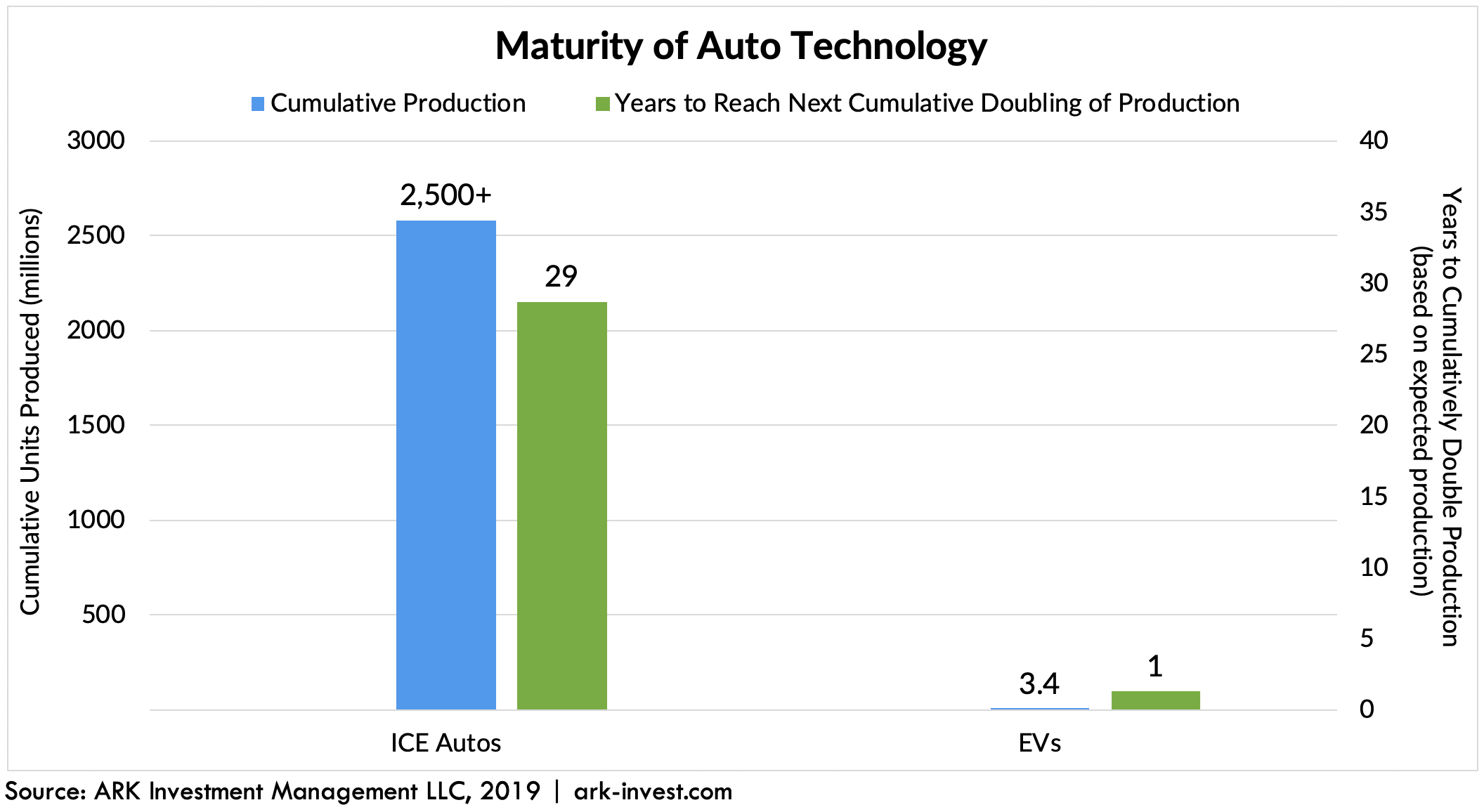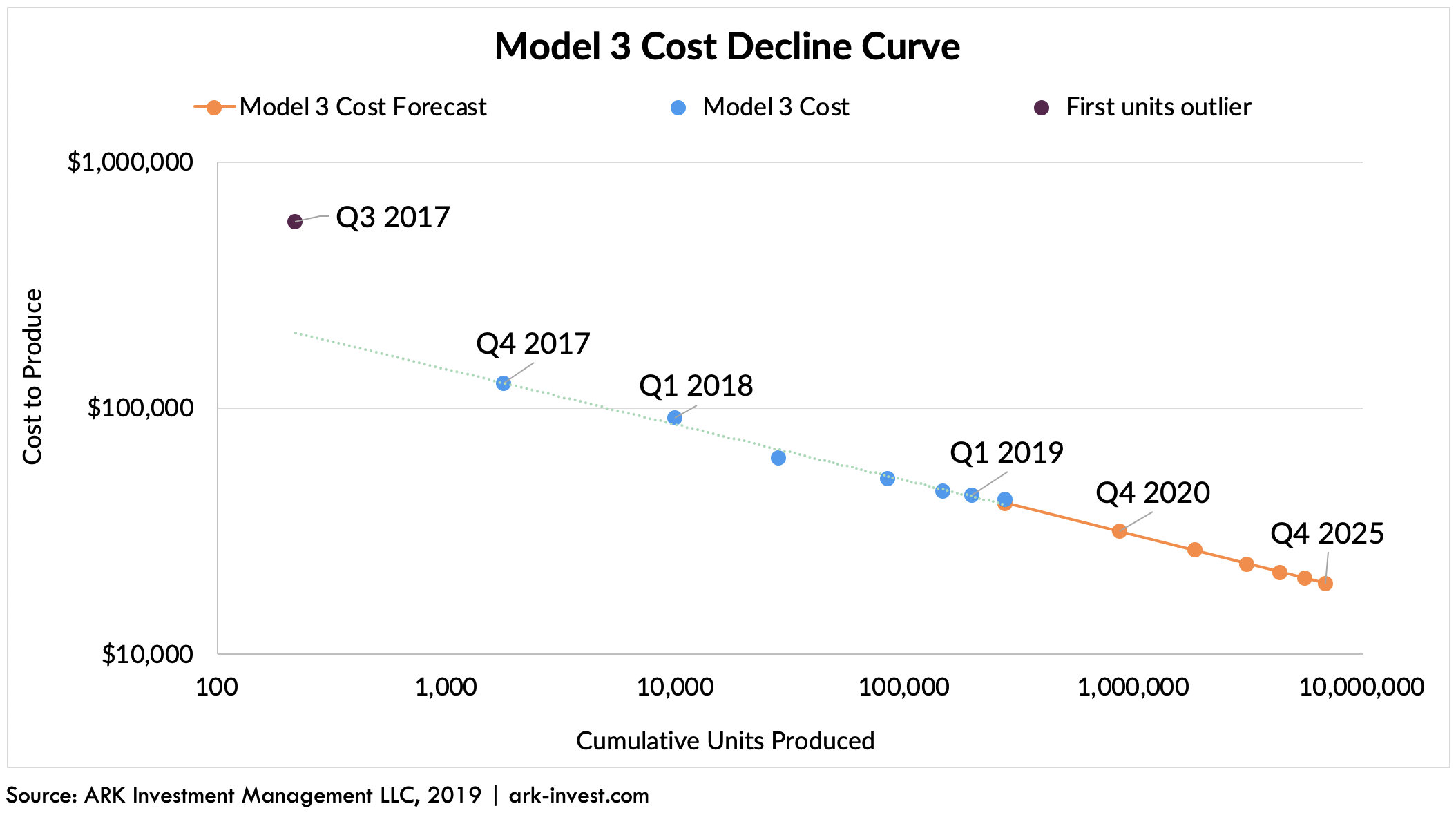
🔭 Wright's Law is the best way to predict the future
Understanding the future is the most valuable knowledge there is. The prime example is Moore's Law. But there is another law with even higher accuracy that can teach us a lot about the future, not at least about electric cars.
Share this story!
Premium Supporters - click here to listen to the audio of this text.
We have many so called laws to understand the future. The most famous is Moore's Law, coined in 1965 in Electronics magazine.
Gordon Moore looked at the number of transistors on the circuits they manufactured at Fairchild Semiconductors and noted that they had doubled in number every year. A single transistor in 1959 had become 64 by 1965.
His prediction was that this exponential development would continue for at least ten years, maybe not doubling every year, but close to it.
Since 1971, the number has indeed doubled every two years, and the transistors on a circuit now number an incredible 19.2 billion.

If you understood Moore's Law you would have been able to predict the future
Moore's article, with the entertaining heading Cramming more components onto integrated circuits, became world-renowned, as it matched reality so well. If you had read Moore's article in 1965 and truly understood what it meant, and acted and invested accordingly, you would have become the world's richest person.
All the digital items we have around us are possible thanks to this development — consumer electronics, supercomputers, home PCs, mobile phones, the internet, smartphones, big data, augmented reality, drones and virtual reality.
By understanding Moore's Law you cannot exactly predict which gadgets will arrive, but you can understand what it is possible to achieve.
A new sheriff, with a new law
Moore's Law has also proven to be a good rule of thumb for other technologies. But now there's a new sheriff in town, and he's following another law: Wright's Law.
Moore's Law focuses on time whereas Wright's Law focuses instead on the number of units produced. For each doubling of production, the associated cost drops by a certain percentage. In this rule of thumb, it is 20 percent.
New rule of thumb: 20 percent reduction in cost when production doubles
If we have so far produced 1000 units of a product, then the cost per unit will decrease by 20% when production reaches 2000 units. Another 20% reduction happens at 4,000, then another at 8,000, and so on.
If the cost of producing 1000 units is $100, then the cost of unit number 2000 will be $80. For unit number 4000, the cost will be $64, and for unit number 8000 it will be $51.
Three doublings in production therefore cut the unit cost almost in half.
Researchers at MIT have compared several of these laws. They went through historical data for 62 different technologies and concluded that Wright's Law comes closest to the truth, closely followed by Moore's Law.
Wright's Law comes fromaircraft manufacturing
Wright's Law originated in an observation from Theodore P. Wright, an aerospace engineer, who noted that for every accumulated doubling of aircraft production, costs fell by about 20 percent. This is also called the Learning Curve or Experience Curve.
The actual percentage reduction varies between the industry and product, but it does stay fairly constant over time. Therefore, it can be used as a rule of thumb to peer into the future.
Wright's Law for the car industry
In the automotive industry, the reduction is about 15 percent for each accumulated doubling of production. It may not feel like this, because we don’t see the price of cars falling. But this is because we are talking about an accumulated doubling of production. Since the car industry has existed for over a hundred years and produced a great many cars during that time, each doubling takes a good many years.
Right now it will take about 29 years for the next doubling to happen, with the current production rate of 90 million cars per year.
Electric motors and batteries are changing Wright's Law for the automotive industry
What might happen is that a key part of the technology in question changes. Instead of an internal combustion engine, we suddenly have an electric motor, and Wright's Law sets off on a new curve.
So far, only about 3.5 million electric cars have been produced, compared to 2.5 billion cars with internal combustion engines. We will therefore see a rapid cost reduction as the number of electric cars increases sharply over the coming years.

According to calculations from ARK Invest, the cost of an average fossil car will decrease 0.5% per year, while the cost of electric cars will decrease by 12% annually.
The best-selling electric car in the world right now, Tesla's Model 3, costs $40,000 in its cheapest version. Within three to four years, that will probably be cheaper than a corresponding fossil fuel car. Not only cheaper to own— an electric car has lower service costs and zero gasoline cost — but it will also be cheaper to buy.

It is uncertain how much of the cost reduction in manufacturing will translate into reduced consumer price. Some of the savings might go back into better battery capacity, more advanced self-driving functions, investments in charging infrastructure, other things that improve the car, or increased profit for the manufacturer. But eitherway, electric cars will seriously begin to compete with fossil cars within the next few years.
No new fossil cars in 2030?
Therefore, I think it likely we will see hardly any new sales of fossil cars by the end of the 2020s. It will simply be financially insane to buy a petrol car.
But we should be a little cautious with long-term predictions. New technologies often come out of nowhere, taking things in a new direction. Therefore it is important to keep abreast of the latest developments. How lucky you are to be WIP, because that’s exactly what we do here.
Translation by Paddy Kelly (check out his books at Amazon!)
This is a premium article, part of our content for Premium Supporters, open for everyone thanks to the members' generous contributions.
By becoming a premium supporter, you help in the creation and sharing of fact-based optimistic news all over the world.


